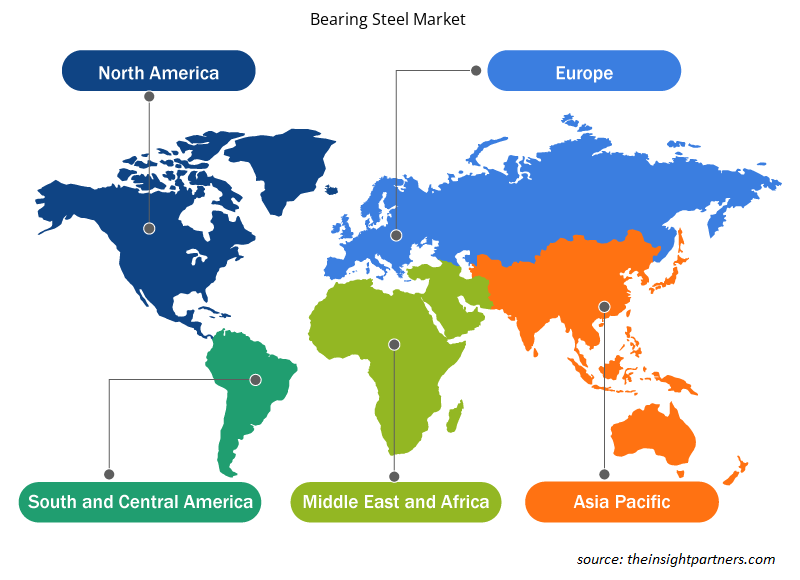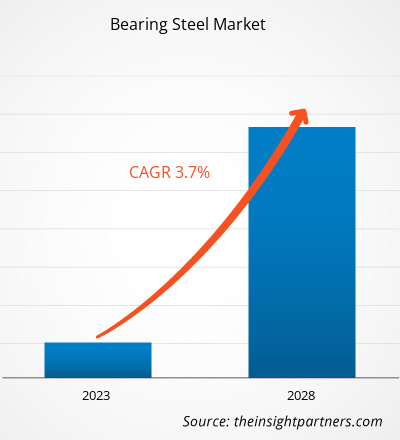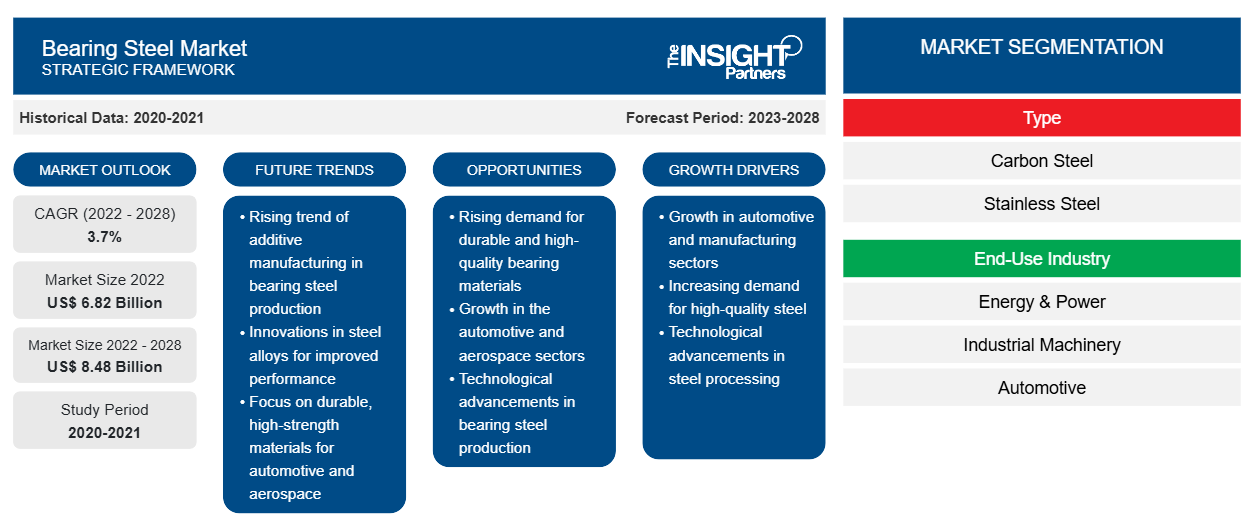[Informe de investigación] Se espera que el tamaño del mercado de acero para cojinetes crezca de US$ 6.824,25 millones en 2022 a US$ 8.476,80 millones en 2028; se estima que registrará una CAGR del 3,7% de 2022 a 2028.CAGR of 3.7% from 2022 to 2028.
El acero para cojinetes es un acero especial que presenta una alta resistencia al desgaste y a la fatiga por rodadura. El acero para cojinetes con alto contenido de cromo y carbono, el acero de ingeniería y algunos tipos de acero inoxidable y acero resistente al calor se utilizan como materiales para cojinetes. La creciente demanda de cojinetes en la industria automotriz y el desarrollo de cojinetes duraderos e inteligentes son los principales factores que impulsan el mercado.
En 2022, Asia Pacífico tuvo la mayor participación en los ingresos del mercado mundial de acero para cojinetes. Asia Pacífico alberga importantes empresas de semiconductores y automotrices, entre las que se incluyen Samsung Electronics Co., Ltd.; Sony Group Corporation; SK Hynix Inc.; Toyota Motor Corporation; Tata Motors Ltd.; Hyundai Motor Company; Nissan Motor Co., Ltd.; y Honda Motor Co., Ltd. El acero para cojinetes se usa ampliamente en motores eléctricos en maquinaria automotriz e industrial, ya que muestra varias propiedades, como una larga vida útil, capacidad para soportar presiones bajas y altas y rentabilidad. Según un informe publicado por la Asociación de Automóviles de Pasajeros de China, en 2022, Tesla Inc entregó 83.135 vehículos eléctricos fabricados en China, lo que indica un crecimiento en las ventas de vehículos eléctricos a partir de 2021. Según el informe de la Organización Internacional de Fabricantes de Vehículos de Motor, en 2021, la producción de vehículos de motor en Asia Pacífico fue de ~46,73 millones de unidades. Por lo tanto, se espera que la creciente industria automotriz en Asia Pacífico cree oportunidades comerciales favorables para el mercado de acero para cojinetes en la región durante el período de pronóstico.
Personalice este informe según sus necesidades
Obtendrá personalización en cualquier informe, sin cargo, incluidas partes de este informe o análisis a nivel de país, paquete de datos de Excel, así como también grandes ofertas y descuentos para empresas emergentes y universidades.
-
Obtenga las principales tendencias clave del mercado de este informe.Esta muestra GRATUITA incluirá análisis de datos, desde tendencias del mercado hasta estimaciones y pronósticos.
Impacto de la pandemia de COVID-19 en el mercado de acero para rodamientos
Antes de la aparición del brote de COVID-19, el mercado de acero para cojinetes estaba creciendo debido al uso cada vez mayor de cojinetes en las industrias de energía y electricidad, maquinaria industrial, automotriz, eléctrica y electrónica y aeroespacial. Sin embargo, la pandemia de COVID-19 obstaculizó el crecimiento del sector de productos químicos y materiales, lo que obstaculizó el crecimiento del mercado de acero para cojinetes. La implementación de medidas para combatir la propagación del SARS-CoV-2 afectó negativamente el crecimiento de varias industrias. Los fabricantes experimentaron retrasos y un aumento de los costos de las materias primas importadas debido al cierre a largo plazo de muchas fábricas. El daño causado por el impacto de la pandemia en las industrias de uso final obstaculizó la demanda de acero para cojinetes.
En 2021, el mercado mundial comenzó a recuperarse de las pérdidas causadas por la pandemia de COVID-19, ya que los gobiernos de diferentes países anunciaron la flexibilización de las restricciones. Se permitió a los fabricantes operar a plena capacidad, lo que les ayudó a superar la brecha entre la oferta y la demanda. Esto tuvo un impacto positivo en el crecimiento del mercado de acero para rodamientos en el escenario posterior a la pandemia.
Perspectivas del mercado
La creciente demanda de rodamientos en la industria automotriz impulsará el crecimiento del mercado de acero para rodamientos
Los cojinetes son un componente vital de las piezas de los automóviles y se utilizan comúnmente en motores, generadores, motores eléctricos, ruedas, cajas de cambios, ejes de transmisión, ejes de dirección y engranajes de dirección. Sus características de capacidad de carga y su capacidad para facilitar la transferencia de par mejoran el rendimiento general de las piezas giratorias de un sistema automotriz. Según la aplicación específica, el rendimiento de los cojinetes se puede mejorar mediante la selección correcta del acero, la tecnología y la lubricación durante la fabricación. El acero al carbono y el acero inoxidable se utilizan ampliamente para fabricar cojinetes. Además, los fabricantes están utilizando nuevas materias primas, como aleaciones de acero ligero, para satisfacer la demanda de materiales ligeros de las empresas automotrices. El uso de materiales ligeros también les permite mantenerse al día con las normas de emisiones cambiantes.
Perspectivas basadas en tipos
Según el tipo, el mercado mundial de acero para cojinetes se segmenta en acero al carbono, acero inoxidable y otros. El acero al carbono es una aleación de carbono (hasta un 2,1 % en peso), hierro y otros elementos. El acero al carbono ofrece una resistencia, capacidad de carga, ductilidad y soldabilidad óptimas. Proporciona una larga vida útil debido a su alta relación resistencia-desgaste. El acero al carbono se utiliza para fabricar cojinetes y componentes de cojinetes de semiprecisión o de grado comercial. El acero al carbono utilizado para cojinetes requiere la aplicación de aceite y grasa, ya que carece de resistencia a la corrosión. Por lo tanto, se utiliza para producir cojinetes necesarios para cajones rodantes, carros de compra, bicicletas, patines, cerraduras y otras aplicaciones donde la lubricación de cojinetes no afecta al proceso industrial.
Ovako AB, Dongbei Special Steel Group Co Ltd, Ezm Edelstahlzieherei Mark Gmbh, Fushun Special Steel Co Ltd, Hbis Group Co Ltd, Saarstahl AG, Kobe Steel Ltd, Baosteel Group Corp, Benxi Iron and Steel Group Co Ltd y Sanyo Special Steel Co Ltd se encuentran entre los actores clave que operan en el mercado global de acero para cojinetes. Los actores del mercado se centran en proporcionar productos de alta calidad para satisfacer la demanda de los clientes. También se centran en estrategias como inversiones en investigación y desarrollo, lanzamientos de nuevos productos y expansión de la capacidad de producción.
Perspectivas regionales del mercado de acero para cojinetes
Los analistas de Insight Partners explicaron en detalle las tendencias y los factores regionales que influyen en el mercado de acero para cojinetes durante el período de pronóstico. Esta sección también analiza los segmentos y la geografía del mercado de acero para cojinetes en América del Norte, Europa, Asia Pacífico, Oriente Medio y África, y América del Sur y Central.

- Obtenga datos regionales específicos para el mercado de acero para cojinetes
Alcance del informe sobre el mercado de acero para cojinetes
| Atributo del informe | Detalles |
|---|---|
| Tamaño del mercado en 2022 | 6.820 millones de dólares estadounidenses |
| Tamaño del mercado en 2028 | US$ 8.48 mil millones |
| CAGR global (2022-2028) | 3,7% |
| Datos históricos | 2020-2021 |
| Período de pronóstico | 2023-2028 |
| Segmentos cubiertos |
Por tipo
|
| Regiones y países cubiertos |
América del norte
|
| Líderes del mercado y perfiles de empresas clave |
|
Densidad de actores del mercado de acero para rodamientos: comprensión de su impacto en la dinámica empresarial
El mercado de acero para cojinetes está creciendo rápidamente, impulsado por la creciente demanda de los usuarios finales debido a factores como la evolución de las preferencias de los consumidores, los avances tecnológicos y una mayor conciencia de los beneficios del producto. A medida que aumenta la demanda, las empresas amplían sus ofertas, innovan para satisfacer las necesidades de los consumidores y aprovechan las tendencias emergentes, lo que impulsa aún más el crecimiento del mercado.
La densidad de actores del mercado se refiere a la distribución de las empresas o firmas que operan dentro de un mercado o industria en particular. Indica cuántos competidores (actores del mercado) están presentes en un espacio de mercado determinado en relación con su tamaño o valor total de mercado.
Las principales empresas que operan en el mercado de acero para cojinetes son:
- Ovako AB
- Grupo de acero especial Dongbei Co. Ltd.
- Ezm Edelstahlzieherei Mark Gmbh
- Fushun Acero Especial Co Ltd
- Grupo Hbis Co. Ltd.
Descargo de responsabilidad : Las empresas enumeradas anteriormente no están clasificadas en ningún orden particular.

- Obtenga una descripción general de los principales actores clave del mercado de acero para cojinetes
Informe Destacado
- Tendencias progresivas de la industria en el mercado de acero para rodamientos para ayudar a los actores a desarrollar estrategias efectivas a largo plazo
- Estrategias de crecimiento empresarial adoptadas por los mercados desarrollados y en desarrollo
- Análisis cuantitativo del mercado de acero para rodamientos de 2020 a 2028
- Estimación de la demanda mundial de acero para rodamientos
- Análisis de las cinco fuerzas de Porter para ilustrar la eficacia de los compradores y proveedores que operan en la industria
- Avances recientes para comprender el escenario competitivo del mercado
- Tendencias y perspectivas del mercado, así como factores que impulsan y restringen el crecimiento del mercado de acero para rodamientos
- Asistencia en el proceso de toma de decisiones destacando las estrategias de mercado que sustentan el interés comercial, lo que conduce al crecimiento del mercado.
- El tamaño del mercado de acero para rodamientos en varios nodos
- Descripción detallada y segmentación del mercado, así como la dinámica de la industria del acero para rodamientos.
- El tamaño del mercado de acero para rodamientos en varias regiones con oportunidades de crecimiento prometedoras
Segmentación del mercado mundial de acero para cojinetes
Según el tipo, el mercado mundial de acero para cojinetes se segmenta en acero al carbono, acero inoxidable y otros. Según el uso final, el mercado de acero para cojinetes se segmenta en energía y electricidad, maquinaria industrial, automoción, electricidad y electrónica, aeroespacial y otros.
Perfiles de empresas
- Ovako AB
- Grupo de acero especial Dongbei Co. Ltd.
- Ezm Edelstahlzieherei Mark Gmbh
- Fushun Acero Especial Co Ltd
- Grupo Hbis Co. Ltd.
- Saarstahl AG
- Acero Kobe Ltd.
- Grupo Baosteel Corp.
- Grupo de hierro y acero Benxi Co. Ltd.
- Acero especial Sanyo Co. Ltd.
- Análisis histórico (2 años), año base, pronóstico (7 años) con CAGR
- Análisis PEST y FODA
- Tamaño del mercado, valor/volumen: global, regional y nacional
- Industria y panorama competitivo
- Conjunto de datos de Excel
Informes recientes
Testimonios
Razón para comprar
- Toma de decisiones informada
- Comprensión de la dinámica del mercado
- Análisis competitivo
- Información sobre clientes
- Pronósticos del mercado
- Mitigación de riesgos
- Planificación estratégica
- Justificación de la inversión
- Identificación de mercados emergentes
- Mejora de las estrategias de marketing
- Impulso de la eficiencia operativa
- Alineación con las tendencias regulatorias























 Obtenga una muestra gratuita para - Mercado de acero para cojinetes
Obtenga una muestra gratuita para - Mercado de acero para cojinetes